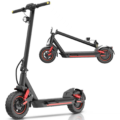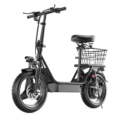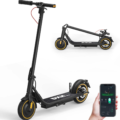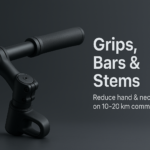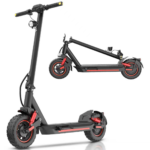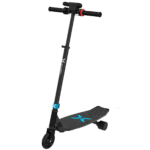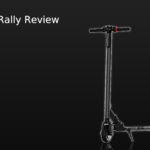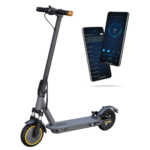- Home
- Scooters
- Electric Scooters
- DXH Kids e-scooter
DXH Kids e-scooter
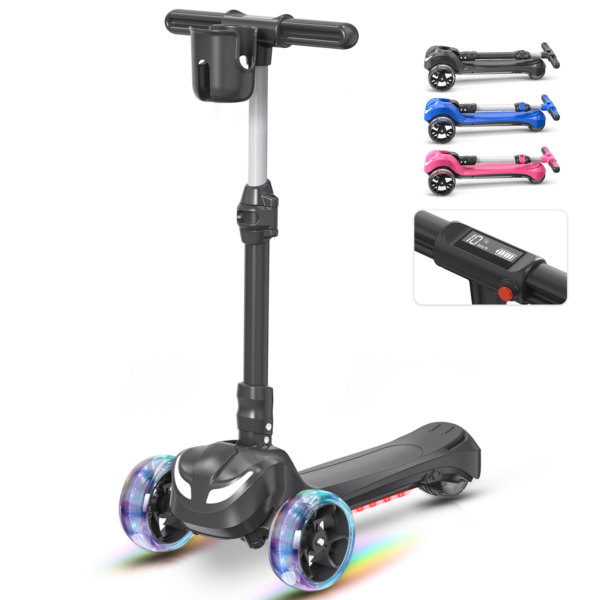

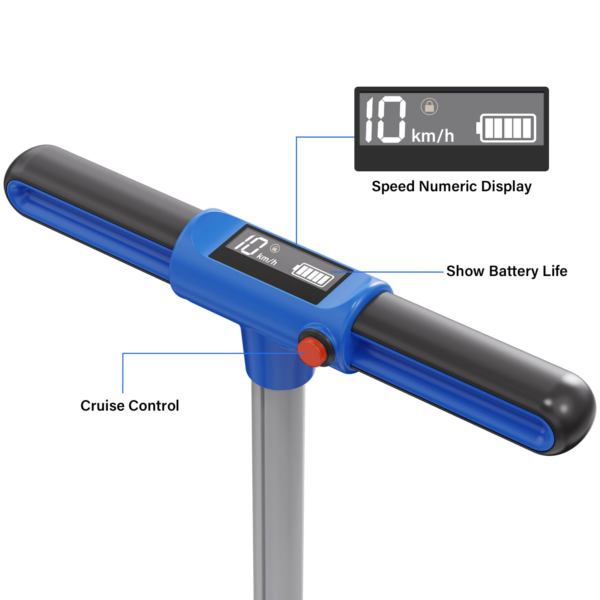
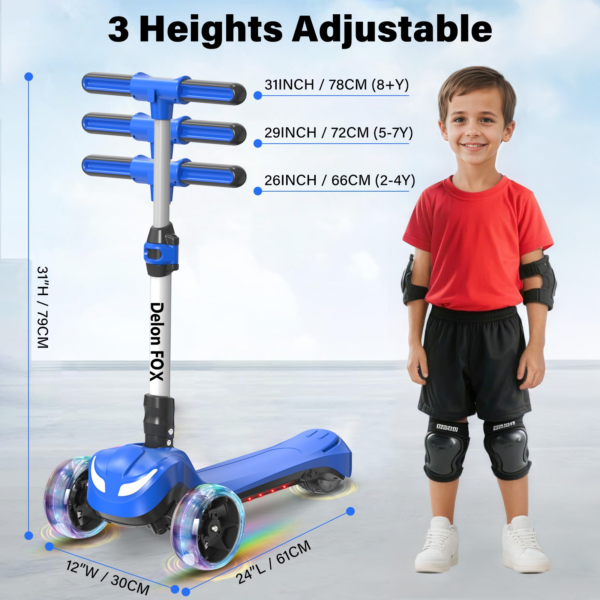
- Battery Range: Not specified
- Top Speed: 5 mph (8 km/h)
- Motor Power: Not specified
- Weight Capacity: 110 lb (50 kg)
- Charging Time: Not specified
- Scooter Weight: Not specified
PROS
- Kid-safe 5 mph (8 km/h)
- 3-wheel stability
- Flashing LED wheels
- LCD screen & thumb throttle
- Adjustable handlebar (3 heights)
CONS
- Range not specified
- Battery capacity not listed
- Braking system not detailed
- IP rating not specified
Table of contents
- What Is the DXH Kids e-scooter?
- How the DXH Kids e-scooter Works
- Key Specifications
- Design & Build Quality
- Performance Fundamentals
- Battery, Range & Efficiency
- Ride Quality & Comfort
- Braking & Safety Features
- Portability & Daily Usability
- Maintenance & Care
- Weather & Seasonal Considerations
- DXH Kids e-scooter vs Alternatives
- Who the DXH Kids e-scooter Is (and Isn’t) For
- FAQs
- Glossary
- Final Thoughts
If your child is asking for their first electric ride, the DXH Kids e-scooter is a simple, low-speed starter designed to be fun and approachable. Moreover, it keeps the pace kid-friendly, adds a bright display and flashy wheels, and uses a stable three-wheel layout that helps new riders feel confident from day one. As a result, parents can supervise with less stress while kids learn core skills. Overall, this overview explains how it works, what to expect on real sidewalks and park paths, and how to keep it in good shape for the long haul.
What Is the DXH Kids e-scooter?
The DXH Kids e-scooter is a three-wheel, entry-level electric scooter built for younger riders who are still learning balance and control. Additionally, it has a low maximum speed to prioritize safety, a thumb throttle that’s easy for small hands, and an LCD screen so kids can see speed and battery status at a glance. Furthermore, the LED wheels light up while rolling, which makes evening play more exciting and also increases visibility.
Because it targets early elementary ages, the scooter includes a height-adjustable handlebar to grow with the rider. In addition, the deck is wide, so feet have room to shuffle and settle. Most importantly, the three-wheel stance and lean-to-steer setup help kids discover how body weight affects turning without the sudden tip-overs that can happen on narrow, two-wheel platforms.
How the DXH Kids e-scooter Works
At a high level, think of it like a very small, electric-assist toy vehicle with simple controls. Consequently, kids focus on posture and stopping rather than on complicated settings.
Motor. A compact hub motor inside one of the wheels adds gentle push once the scooter is rolling. Instead of chasing speed, it gives a steady, predictable boost that feels more like a moving walkway than a rocket. Because delivery is calm, new riders aren’t surprised by jerky takeoffs.
Controller. A small electronic controller acts as the scooter’s “brain.” It reads throttle position, limits output to a kid-safe speed, and smooths changes. Therefore, when your rider eases off, the scooter coasts down rather than cutting abruptly.
Battery. A lightweight battery stores the energy that powers the motor and LCD. Kids don’t see the battery, but they see its status bar on the display. Naturally, more bars mean more playtime. When it drops low, you plug in the charger, just like you would with a tablet.
Thumb throttle. The throttle is a little lever near the right grip. Kids press it with their thumb to “ask for more go.” Then, when they release, the scooter slows. This action is intuitive and avoids awkward wrist twisting.
Brakes. Young riders typically use a rear fender step-brake or mild electronic slowing, depending on configuration. To build habits, teach the sequence: roll, press throttle, release, and step on the back fender to stop. After a few tries, the pattern becomes automatic.
Steering and stability. The DXH Kids e-scooter uses a lean-to-steer system. Accordingly, kids shift weight to guide turns—much like carving on a scooter board—but the dual front wheels and overall stance keep it from flopping side to side. That extra footprint builds confidence, especially in early sessions.
Altogether, these elements create a consistent, forgiving ride that teaches basics without overwhelming new users.
Key Specifications
The table below consolidates the manufacturer’s official details and plainly notes items that are not listed publicly. Additionally, where items are “not specified,” you can confirm details in the printed manual that ships with the product.
| Block | Item | Specification |
|---|---|---|
| General | Intended rider | Children |
| Suggested age | 3–8 years | |
| Max rider weight | 110 lb (50 kg) | |
| Colors | Pink, Blue, Black | |
| Display | LCD screen (speed & battery) | |
| Performance & Power | Top speed | 5 mph (≈ 8 km/h) |
| Motor type | Hub motor (power not specified) | |
| Drive | Front/Rear hub (not specified) | |
| Hill grade | Light neighborhood slopes (exact grade not specified) | |
| Battery, Charging & Electrical | Battery type/capacity | Not specified by manufacturer |
| Estimated ride time | Not specified by manufacturer | |
| Charging time | Not specified by manufacturer | |
| Charger | Included (details not specified) | |
| Lighting | Self-powered LED flashing wheels; additional lights not specified | |
| Build & Dimensions | Frame layout | Three-wheel, lean-to-steer |
| Handlebar height | 28.5–31.6 in (72.4–80.3 cm), 3 levels | |
| Deck | Extra-wide kids deck | |
| Fold mechanism | Not specified by manufacturer | |
| Unfolded dimensions | Not specified by manufacturer | |
| Folded dimensions | Not specified by manufacturer | |
| Safety & Control | Primary braking | Not specified by manufacturer (typical: rear fender step-brake) |
| Tires/wheels | Three small wheels with LED lighting; sizes not specified | |
| Water protection | Not specified by manufacturer (no IP rating listed) | |
| Features & Extras | Throttle | Thumb throttle |
| Height adjust | 3 positions | |
| LED effects | Self-generating flashing wheels | |
| Display | LCD (speed, battery) | |
| Cruise Control | Not specified by manufacturer | |
| Warranty & Compliance | Warranty | 1-Year limited warranty (seller/manufacturer policy) |
| Compliance | UL2272 certification claimed |
Notes: Items marked “not specified” reflect missing public details. In practice, if you need a field such as battery capacity, check the in-box documentation.
Design & Build Quality
The DXH Kids e-scooter prioritizes stability and simplicity. Specifically, the three-wheel stance spreads weight across a wider footprint than a typical two-wheel kick scooter. As a result, side-to-side wobble decreases and confidence rises, especially for riders moving from non-electric toys. Because the lean-to-steer front end rewards smooth body movement, kids naturally discover how gentle shifts create smooth arcs.
The deck is broad and flat, which matters more than it seems. A wide deck lets kids test foot positions—side-by-side to start, then staggered as comfort grows—without catching edges. Meanwhile, rubberized grips feel soft and secure. Since the thumb throttle sits close to the right grip, shorter thumbs can reach it without stretching or twisting.
Fit-and-finish is appropriate for a children’s product. Edges are rounded, the battery is enclosed, and the plastics feel durable. Notably, the LCD is bright enough for daylight glances. Kids love the wheel lighting because it makes the scooter feel “alive.” Parents appreciate that the wheel LEDs are self-powered, so they glow without draining the main battery.
Finally, the adjustable handlebar height extends the scooter’s usefulness. You can start a smaller child at the lower setting, then bump it up as they grow. Consequently, siblings can share the same unit with a quick height change.
Performance Fundamentals
How it accelerates
Acceleration feels gentle by design. From a short push-off, the motor adds steady assistance. Therefore, new riders can focus on posture, steering, and braking instead of raw speed. There’s no dramatic surge when the throttle goes down; rather, it’s a mild “nudge” forward that helps kids practice smooth control.
Cruising and stability
Once rolling, the scooter prefers smooth, flat surfaces—driveways, cul-de-sacs, park paths, and indoor gym floors. Because the three-wheel stance reduces twitchiness, line-holding at low speed is easier than on narrower decks. On uneven pavement, remind your rider to bend the knees and keep both hands steady. In most cases, the stable geometry forgives small bumps without tossing the rider.
Hill behavior
This is a kids’ scooter with a small motor and a low speed cap. Accordingly, it handles gentle neighborhood slopes but not long or steep grades. If your area has rolling terrain, coach your rider to start with a small push and maintain momentum. However, if the hill is too steep, walk the scooter up and ride down in a straight line at a safe pace.
Battery, Range & Efficiency
Rated vs real-world expectations
Because the manufacturer doesn’t publish battery capacity or an official ride-time estimate, set expectations based on use patterns. Short play sessions with plenty of coasting can stretch a charge. Conversely, constant throttle on rough pavement will reduce run time. In practice, kids naturally vary speeds, stop often, and explore, which tends to extend play across typical backyard or sidewalk sessions.
Factors that affect range
- Rider weight. Heavier riders consume more energy at a given speed. Therefore, stay within the 110 lb (50 kg) limit.
- Surface and slope. Smooth concrete uses less energy than chunky asphalt or grass. Likewise, gentle hills draw more power than flat loops.
- Temperature. Batteries prefer mild conditions. In cold weather, output drops; in heat, protective limits may kick in.
- Stop-and-go. Repeated starts use more energy than steady coasting. Consequently, smooth riding helps.
Charging best practices
- Top off before outings. A full battery makes for a smoother session.
- Use the included charger only. Chargers look similar but may not match voltage; mismatches shorten lifespan.
- Cool down first. If the scooter feels warm, let it rest before charging.
- Avoid deep storage discharge. If you store it for weeks, charge to around half and top up monthly.
- Keep the port clean and dry. Close the rubber cap (if equipped) after charging.
Altogether, these habits protect the pack and maximize lifespan, even without a printed capacity figure.
Ride Quality & Comfort
Ride feel comes from three parts: the deck, the steering system, and the wheels.
- Deck and stance. The wide deck lets kids stand naturally. Initially, beginners plant both feet parallel; later, they shift to a lead-foot stance for better control.
- Lean-to-steer. Unlike a bicycle’s pivoting fork, lean-to-steer requires body input. As a result, it promotes balance, coordination, and smoother turns.
- Wheels. The small wheels keep weight low and turn-in quick, which suits neighborhood speeds. In addition, the light-up effect adds visibility and joy.
Because there’s no published suspension, comfort relies on wheel compliance and rider technique. Therefore, encourage bent knees over cracks and choose smooth surfaces whenever possible. Also, teach kids to look ahead for seams and leaves, then roll over them straight to avoid snagging a wheel.
Braking & Safety Features
Stopping remains simple: release the throttle first, then use the brake. Many kids’ scooters rely on a rear fender step-brake that presses against the wheel. Although the brand does not list a specific mechanism here, you can introduce your child to the routine in a quiet space:
- Coast with throttle off.
- Shift weight slightly back.
- Step on the rear fender to slow to a stop.
Because the top speed is just 5 mph (≈ 8 km/h), braking distances are short on dry pavement. However, on wet leaves or dust, traction falls, so plan longer stopping room. The wheel LEDs help with dusk visibility; nevertheless, a supervising adult should always be present. Helmets are non-negotiable; knee and elbow pads are strongly encouraged for first rides.
The brand cites UL2272 compliance, which relates to electrical and fire safety for hoverboard-class products and similar light EV toys. While that offers reassurance, it does not replace common-sense riding rules.
Portability & Daily Usability
This is a compact children’s scooter, so carrying it from car to sidewalk is easy for adults and manageable for older kids. Additionally, the adjustable handlebar lets you set a comfortable height for each rider. Because the manufacturer doesn’t list a folding mechanism, plan to store it in one piece—under a coat rack, beside a garage wall, or in a toy corner.
For quick trips to the park, a soft loop strap (secured around the stem) helps adults carry it hands-free while holding a child’s hand. Also, keep the charger in a labeled drawer at home, not in a backpack where it might bang around or get wet.
As for security, this is a children’s toy more than a commuter vehicle. Therefore, supervise riding, bring it back inside after play, and avoid leaving it at a park bench unattended.
Maintenance & Care
A simple routine keeps the DXH Kids e-scooter rolling reliably. Moreover, regular micro-checks prevent small issues from becoming big ones.
Before each ride (30 seconds).
- Check that the handlebar clamp (if present) is snug.
- Squeeze or step on the brake to ensure it engages.
- Confirm the display powers on and shows battery bars.
- Spin the wheels to ensure nothing rubs or binds.
Every 2–4 weeks.
- Wipe the deck and wheels with a damp cloth to remove grit.
- Inspect the rear fender for cracks.
- Look for loose screws at the stem, deck, and wheel housings.
- Verify the throttle snaps back when released.
Charging habits.
- Plug in after play so it’s ready for the next day.
- Don’t leave it charging overnight in cramped or hot spaces.
- Coil the cable gently and store it where kids can’t trip on it.
Storage.
- Keep it indoors, away from direct sun and moisture.
- If storing for a month or longer, charge to roughly half and top up monthly.
In short, this light-touch schedule protects both electronics and hardware with minimal effort.
Weather & Seasonal Considerations
Like most kids’ scooters, the DXH Kids e-scooter is built for dry conditions. There’s no listed IP rating, so treat it as “avoid rain and puddles.” If you’re caught by a surprise sprinkle:
- Slow to a walking pace. Wet surfaces reduce grip, even at kid speeds.
- Dry afterward. Wipe the deck and wheels with a towel.
- Air it out. Store in a dry room, not a damp garage corner.
Cold weather. In winter, batteries deliver less power. Consequently, expect shorter play sessions and slower acceleration. Consider indoor gym floors or smooth basements for supervised rides, if allowed and safe.
Hot weather. Avoid leaving the scooter in a parked car or in direct sun for long periods. If the deck feels hot to the touch, let it cool before charging. Additionally, encourage water breaks to keep riders comfortable.
Leaves and sand. These are slick. Therefore, practice slow rolls over debris and straight-line crossings. Turn only on clear surfaces.
DXH Kids e-scooter vs Alternatives
When comparing children’s scooters, start with intent. This model emphasizes stability, low spWhen comparing children’s scooters, start with intent. This model emphasizes stability, low speed, and simple controls—ideal for first-timers ages 3–8. If your child is older, heavier, or already comfortable at faster speeds, a two-wheel kids scooter with a higher cap may suit better. For deeper context and a look at what a step-up kids model can feel like, see the Hover-1 Vivid review. Likewise, for a very early-age option, compare with the Hover-1 My First e-Scooter.
- Stability-first (this scooter). Best for cautious riders and parents who want the slowest, steadiest experience. The lean-to-steer and three-wheel stance help new riders build skills without sudden tip-overs.
- Step-up two-wheel kids models. These typically raise the speed limit and demand more balance. Consequently, they suit elementary riders who already zip around on kick scooters and want a bit more pace.
- Teen commuter-style e-scooters. Heavier, faster, longer-range platforms belong to older kids and teens who can manage traffic awareness, signaling, and route planning. They trade stability for range and speed.
- Off-road toys. Wide tires and springy frames roll over dirt and grass. However, they require more space and adult supervision, and they aren’t ideal for narrow sidewalks.
Overall, the DXH Kids e-scooter stands out when you want short, supervised play sessions, bright visual flair, and a forgiving first electric experience. It is not the right pick for long rides, steep terrain, or riders approaching the 110 lb (50 kg) limit.
Who the DXH Kids e-scooter Is (and Isn’t) For
Perfect for:
- Young beginners who feel nervous on narrow, two-wheel toys.
- Families who value low speed, high stability, and simple controls.
- Neighborhood play on smooth sidewalks, park loops, and driveways.
- Siblings who need adjustable handlebar height to share a scooter.
Not ideal for:
- Kids who already ride fast kick scooters and want more speed.
- Hilly neighborhoods or long path rides.
- Wet climates where puddles and rain are common.
- Households seeking a school-day, transportation-grade scooter.
Match the scooter to your child’s stage, not just their age. When the product fits current skills, confidence grows faster and crashes happen less often.
FAQs
1) How fast does it go, and can I limit it further?
It’s capped at about 5 mph (≈ 8 km/h). That’s a brisk jog. Because the scooter already prioritizes low speed, further limiting usually isn’t necessary. Instead, supervise first rides and set the handlebar height so arms stay relaxed.
2) How long does the battery last on a charge?
The brand doesn’t publish a time estimate. Run time depends on rider weight, terrain, temperature, and stop-and-go habits. Consequently, plan for short play sessions and recharge afterward.
3) What’s the difference between lean-to-steer and normal handlebars?
Lean-to-steer turns when your child shifts body weight, which encourages balance and smoother arcs. Conversely, conventional handlebars steer like a bicycle. For new riders, lean-to-steer often feels more forgiving.
4) Can my 9-year-old ride it?
The suggested range is 3–8 years and up to 110 lb (50 kg). If your child is taller, heavier, or already skilled, a larger two-wheel kids model may be better.
5) Is it safe to ride in the rain?
There is no listed IP rating. Therefore, avoid rain, puddles, and wet surfaces. If the scooter gets damp, dry it and store it indoors before charging.
6) Does it fold?
The manufacturer doesn’t specify a folding mechanism for this model. Accordingly, plan to store it unfolded.
7) Where can I find a “DXH Kids e-scooter overview” to share with other parents?
You’re reading one right now. Use these sections—design, performance, maintenance, and safety—to brief family members or babysitters before playtime.
Glossary
- Ah (amp-hours): Battery capacity measure; higher Ah generally means longer runtime.
- Wh (watt-hours): Total energy capacity (volts × amp-hours); best single number for battery size.
- Hub motor: Electric motor built into a wheel hub; compact and quiet.
- Controller: Electronic module that manages power and enforces speed limits.
- Thumb throttle: Small lever near the grip that controls motor assist.
- Lean-to-steer: Turning system that responds to rider lean rather than big handlebar rotations.
- Deck: The platform where riders stand.
- Stem: The vertical tube connecting the deck to the handlebar.
- Stem flex: Slight bending in the stem under load; minimal flex feels steadier.
- UL2272: Safety standard related to electrical and fire tests for small rideables.
- IP rating: Ingress Protection code for water/dust resistance; not listed here.
- Regen: Regenerative braking that converts motion back into battery power (not specified on this model).
- Foot brake: Rear fender step-brake commonly used on kids’ scooters.
- Tread grip: How well the wheels hold on different surfaces.
- Cutoff: The speed or power limit enforced by the controller for safety.
Final Thoughts
The DXH Kids e-scooter is about fun, confidence, and skill-building—not speed. Because the three-wheel stance keeps early riders upright while they learn lean-to-steer and throttle control, practice feels playful instead of tense. Additionally, the bright display and flashy wheels make rides feel special, and the low top speed helps parents relax during supervised play.
You won’t get commuter-grade range or hill power here, and you won’t find a spec sheet packed with numbers. Nevertheless, you get a simple, beginner-friendly scooter that matches the early years—steady, forgiving, and straightforward to maintain. If your goal is to introduce electric riding in the safest, calmest way, this remains a sensible place to start.
Specifications
General
| Model The Model specifies the exact version or name of the scooter. It helps identify its unique design, features, and specifications within the manufacturer’s product line. Knowing the model makes it easier to compare options, find compatible accessories, or look up support information. | Kids e-scooter |
| Brand The Brand identifies the manufacturer or company that designs and produces the scooter. A trusted brand is a sign of quality, reliability, and good customer support. Well-known brands often have higher standards for safety, performance, and after-sales service, giving you more confidence in your purchase. | DXH |
| Release Date The Release Date indicates when the scooter model was officially launched on the market. This helps you know how current the design, technology, and features are. A newer release date often means updated components, improved performance, and the latest safety or smart features. | 17 November 2025 |
| Recommended Age Recommended Age indicates the minimum age range that the scooter is designed for, based on safety, size, and ease of use. Following the recommended age helps ensure that riders can handle the scooter’s speed, weight, and controls comfortably and safely. Always check local laws and use protective gear, especially for younger riders. | 3–8 |
Performance & Power
| Motor Power (Wattage) What it means: The motor power, measured in watts (W), shows how strong the scooter’s electric motor is. Why it matters: Higher wattage usually means better acceleration, more torque, and improved performance on hills or rough terrain. For example, a 250W motor is good for flat city roads and light riders, while a 500W or 1000W motor provides more power for faster speeds or climbing steep inclines. | Three-wheel kids e-scooter (motor not specified) |
| Top Speed The Top Speed indicates the maximum speed that the scooter can reach under optimal conditions. It’s usually measured on level ground with a fully charged battery and an average rider weight. A higher top speed allows you to travel longer distances faster, but always ensure you ride within legal speed limits and your personal comfort zone for safety. | 5 mph (8 km/h) |
| Battery Capacity Battery Capacity refers to the total amount of energy the scooter’s battery can store, usually measured in ampere-hours (Ah) or watt-hours (Wh). A higher battery capacity means you can ride longer distances on a single charge, reducing the need for frequent recharging. Keep in mind that actual range can vary depending on rider weight, terrain, speed, and weather conditions. | Not specified |
| Estimated Range per Charge The Estimated Range per Charge indicates the average distance the scooter can travel on a single full battery charge. This range is calculated under optimal conditions, such as flat terrain, moderate speed, and average rider weight. Real-world range may vary depending on riding style, terrain, weather, and load. A longer range means fewer recharges and greater freedom for longer trips. | Not specified |
| Hill Climb Ability Hill Climb Ability describes the maximum incline or slope that the scooter can handle while maintaining stable performance. It’s typically expressed as a percentage or in degrees. A higher hill climb rating means the scooter can tackle steeper hills without losing too much speed or power. Actual climbing performance may vary based on rider weight, battery charge, and terrain conditions. | Not specified |
| Drive System The Drive System refers to how power from the motor is delivered to the wheels. Electric scooters typically use either a hub motor (directly integrated into the wheel) or a chain/belt drive system. A high-quality drive system ensures smooth acceleration, efficient power transfer, and low maintenance. The choice of drive system affects performance, noise level, and overall ride experience. | Not specified |
Charging & Electrical
| Charging Time Charging Time indicates how long it takes to fully recharge the scooter’s battery from empty to 100% using the standard charger provided. Faster charging means less downtime and more time on the road. Actual charging time may vary slightly depending on battery capacity, charger output, and environmental conditions. | Not specified |
| Battery Type Battery Type refers to the specific technology used in the scooter’s battery, which affects performance, lifespan, weight, and charging time. Most modern electric scooters use high-quality lithium-ion (Li-ion) batteries because they offer a good balance of energy density, durability, and low maintenance. A reliable battery type ensures consistent power delivery and longer riding ranges. | Not specified |
| Removable Battery A Removable Battery means the battery pack can be easily detached from the scooter for convenient charging and replacement. This feature allows you to charge the battery separately, swap it with a spare for extended range, or securely store it indoors in extreme weather. Removable batteries add flexibility and make it easier to keep your scooter powered up wherever you are. | Not specified |
| Regenerative Braking Regenerative Braking is an energy-saving feature that converts some of the energy normally lost during braking back into battery power. When you slow down or brake, the motor works in reverse to generate electricity, which helps extend the scooter’s range and improves overall efficiency. This system also reduces wear on traditional brake components, leading to lower maintenance over time. | Not specified |
| Lighting Lighting refers to the built-in front and rear lights that enhance visibility and safety when riding in low-light conditions or at night. Good lighting helps you see the road ahead and ensures that other road users can see you. Many scooters include LED headlights, taillights, and sometimes brake lights or side reflectors for added safety and compliance with local traffic regulations. | LED flashing wheels; small LCD indicator |
Build & Dimensions
| Scooter Weight Scooter Weight refers to the total weight of the scooter when fully assembled, including the battery. This affects how easy it is to carry, lift, and store the scooter when not in use. A lighter scooter is more portable and convenient for commuting, especially if you need to carry it upstairs or onto public transport. Keep in mind that a sturdy frame and quality components may add to the weight but also contribute to better durability and ride stability. | Not specified |
| Maximum Rider Weight Maximum Rider Weight indicates the highest rider weight that the scooter is designed to safely support while maintaining optimal performance and stability. Staying within this limit helps ensure reliable acceleration, braking, and climbing ability, and it protects the frame, suspension, and motor from excessive strain. Exceeding the recommended limit may reduce performance and increase wear on components. | 110 lb (50 kg) |
| Deck Size Deck Size refers to the dimensions of the scooter’s standing platform. A wider and longer deck provides more foot space, allowing you to stand comfortably and adjust your stance while riding. A well-sized deck improves balance and stability, especially on longer rides or at higher speeds. Compact decks, on the other hand, help keep the scooter lightweight and portable. | Three-wheel, tilt-steer design |
| Handlebar Height Handlebar Height refers to the distance from the deck to the handlebars, which affects your riding posture and comfort. An appropriate handlebar height helps you maintain good balance, reduces strain on your back and arms, and makes steering more comfortable. Some scooters have adjustable handlebars to fit riders of different heights, while others have a fixed height for a streamlined design. | 3-level adjustable (exact range not specified) |
| Folding Mechanism The Folding Mechanism describes how easily and securely the scooter can be folded for carrying and storage. A well-designed folding system lets you quickly collapse the scooter into a compact size, making it convenient to transport on public transit, store under a desk, or fit into a car trunk. Look for sturdy latches and safety locks to ensure the scooter stays firmly in place when folded or unfolded. | Foldable design (not detailed) |
| Dimensions Folded Dimensions indicate the size of the scooter when it’s fully folded. This measurement shows how much space the scooter will take up when stored or carried, making it easier to check if it will fit in your car trunk, under a desk, or in a closet. Compact folded dimensions are ideal for commuters who need to bring their scooter on public transport or store it in tight spaces. | Unfolded: Not specified; Folded: Not specified |
| Material Material refers to the primary construction materials used for the scooter’s frame and key components. High-quality materials like aircraft-grade aluminum, reinforced steel, or durable composites provide strength, stability, and a lighter overall weight. A sturdy material ensures the scooter can handle daily wear and tear while maintaining safety and performance. | Not specified |
Safety & Control
| Brake Type(s) Brake Type(s) describe the braking systems the scooter uses to help you slow down or stop safely. Common brake types include mechanical brakes (like drum or disc brakes), electronic brakes, and foot brakes. Many scooters combine multiple braking systems for added safety and shorter stopping distances. The type and quality of brakes affect your control, especially when riding at higher speeds or on slopes. | Not specified |
| Suspension Suspension refers to the system that absorbs shocks and vibrations while riding, providing a smoother and more comfortable ride over uneven or rough surfaces. Scooters may have front suspension, rear suspension, or dual suspension for better shock absorption and stability. Good suspension helps reduce rider fatigue and improves control, especially when riding on bumpy roads or off-road paths. | None |
| Tire Type Tire Type refers to the kind of tires the scooter uses, which directly affects ride comfort, traction, and maintenance. Common types include solid (airless) tires, pneumatic (air-filled) tires, or hybrid options. Pneumatic tires offer better shock absorption and a smoother ride on rough surfaces, while solid tires are puncture-proof and require less upkeep. The right tire type helps ensure safe handling and a comfortable ride in different conditions. | LED flashing PU wheels |
| Tire Size Tire Size indicates the diameter and width of the scooter’s tires, which affect ride comfort, stability, and how well the scooter handles different terrains. Larger tires generally offer better shock absorption and a smoother ride over bumps and rough surfaces, while smaller tires keep the scooter lighter and more portable. Choosing the right tire size helps ensure a balance between agility and comfort. | Not specified |
| Kickstand The Kickstand is a built-in stand that allows you to park your scooter upright when it’s not in use. A sturdy kickstand keeps the scooter stable and prevents it from tipping over, protecting it from scratches and damage. It also makes storing and accessing your scooter more convenient, whether you’re at home, work, or on the go. | Not specified |
| Water Resistance Rating Water Resistance Rating indicates how well the scooter is protected against water and moisture, usually shown as an IP (Ingress Protection) rating. This rating helps you understand whether the scooter can handle light rain, splashes, or wet roads without damage. While most scooters are not fully waterproof, a good water resistance rating adds peace of mind when riding in changing weather conditions. Always avoid deep puddles or submerging the scooter to protect its electrical components. | Not specified |
Features & Extras
| Display/Console The Display (or Console) shows important real-time information about your ride, helping you monitor your scooter’s status at a glance. Typical displays show speed, battery level, distance traveled, and riding mode. Some models also include additional features like Bluetooth connectivity, app integration, or backlighting for better visibility at night. A clear and easy-to-read display enhances safety and convenience on every trip. | Small LCD (battery/speed icons) |
| Ride Modes Ride Modes refer to the different speed and power settings you can choose to match your riding style or road conditions. Common modes include eco for maximum range and energy efficiency, standard for everyday balance, and sport or turbo for higher speed and stronger acceleration. Switching between ride modes allows you to customize performance, conserve battery, and ride safely in various environments. | Not specified |
| Smart App Connectivity Smart App Connectivity lets you pair your scooter with a dedicated mobile app via Bluetooth. Using the app, you can monitor real-time ride stats like speed, battery level, and range, adjust settings such as ride modes or cruise control, lock the scooter for added security, and sometimes receive firmware updates. This feature adds convenience and allows you to personalize your riding experience right from your smartphone. | No app |
| Anti-Theft System The Anti-Theft System helps protect your scooter from unauthorized use or theft. This feature can include built-in alarms, electronic motor locks, GPS tracking, or remote locking through a mobile app. A good anti-theft system provides peace of mind when parking your scooter in public spaces, adding an extra layer of security to safeguard your investment. | Not specified |
| Cruise Control Cruise Control allows you to maintain a steady speed without continuously holding the throttle. This feature makes longer rides more comfortable by reducing hand fatigue and providing a smoother, more relaxed riding experience — especially on flat, open roads or bike lanes. For safety, cruise control can usually be easily activated or deactivated while riding. | No |
| Accessories Included Accessories Included lists the additional items that come with the scooter to enhance your riding experience and convenience. Common accessories may include a charger, kickstand, bell, lights, phone holder, or carrying strap. These extras add value by making your scooter safer, easier to use, and ready to ride straight out of the box. | Charger included (spec not stated) |
Warranty & Compliance
| Warranty Period The Warranty Period indicates how long the manufacturer guarantees the scooter against defects in materials and workmanship under normal use. A good warranty provides peace of mind, showing the brand’s confidence in its product quality. Always check what parts are covered, such as the frame, battery, and motor, and follow the maintenance guidelines to keep your warranty valid. | 1-year |
| Certifications Certifications confirm that the scooter meets specific safety, quality, and environmental standards set by recognized organizations or regulatory bodies. Common certifications may include CE, RoHS, UL, or other local compliance marks, depending on your region. These certifications ensure that the scooter is manufactured to high standards and is safe and legal to use in your country. | Region-dependent |


